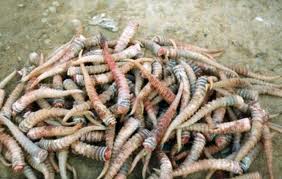1. Ice Age
Today, Saiga (Saiga tartica tartica) are found in four populations across central Asia’s semi-arid desert (Russia, Kazakhstan & Uzbekistan)… but if we glance back to the woolly mammoth era (c.10,000 years ago), this antelope could be seen widely across Europe and even in the UK.
2. Steppe Cousins
There are in fact two subspecies of saiga – Saiga tartica tartica and Saiga tartica mongolica. The latter, as its name suggests, is found in two confined regions of the Mongolian steppe. Smaller in stature than it’s more widely distributed cousin, S. t. mongolica has been reduced to just a few hundred individuals.

Saiga antelope at the Centre for Wild Animals, Kalmykia. These animals are bred in a large paddock before being released back into the wild herds. (Image Credit: Leejiah Dorward)
3. Elephant-Nose
Saigas possess a bizarre elephant-like nose, which has sparked an equally bizarre string of possible explanations. It now thought that the nose evolved to filter the dusty air blown across the steppe.
4. A dusty pilgrimage
Saigas embark on an epic migration each year – moving up to 1000km in search of fresh grasslands. There evidence suggesting that the migration routes are shifting northwards in response to desertification.
A male saiga showing off his winter coat. (Image Credit: Saiga Resource Centre)
5. Speed
Saigas are rapid, achieving speeds up to 50mph! Steppe wolves prowl the grasslands, so even the calves need to act fast.
6. Precious Horns
Male saigas possess an impressive pair of translucent horns, which are particularly sought after in traditional Chinese medicine. Intensive poaching for horn-bearing males has led to a recent reproductive collapse – with so few males, pregnancy rates are at an all time low.

Seized horns en route to southeast Asia. (Image credit: Google images)
7. Critically Endangered
The meltdown of the Soviet Union in 1991 kickstarted poaching for saiga horns and meat. What followed is known to be the greatest decline of any known large mammal to date. In a little over decade, saiga numbers dropped by 90% and it is now considered a Critically Endangered species on the International Union for Conservation of Nature’s Red List.
8. Bouncing Back
Saigas regularly give birth to twins. This, combined with early female reproductive maturity and short gestation period (150 days), means that saigas have the ability to ‘bounce back’ quickly from low population sizes if given the chance. Organisations such as the Saiga Conservation Alliance – a consortium of researchers and NGOs – continue to work with local people and government to help secure the future of this unique ungulate.
